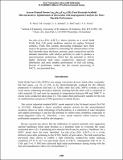Screen printed porous La0.20Sr0.25Ca0.45TiO3 fuel electrode scaffold microstructures : Optimisation of interaction with impregnated catalysts for more durable performance
Abstract
La0.20Sr0.25Ca0.45TiO3 (LSCTA-) shows promise as a novel Solid Oxide Fuel Cell anode backbone material (to replace Ni-based cermets). Thick film ceramic processing techniques have been used as the primary method in controlling the characteristics of the fuel electrode (layer thickness, porosity, grain connectivity and the ultimate interaction with catalyst particles) in order to produce a microstructural architecture which has the potential to deliver higher electronic (and ionic) conductivity, improved current distribution and more durable performance in fuel cell testing. Results of preliminary studies into the ceramic processing of LSCTA- are presented here.
Citation
Price , R , Cassidy , M , Schuler , J A , Mai , A & Irvine , J T S 2015 , Screen printed porous La 0.2 0Sr 0.25 Ca 0.45 TiO 3 fuel electrode scaffold microstructures : Optimisation of interaction with impregnated catalysts for more durable performance . in K Eguchi & S C Singhal (eds) , 14th International Symposium on Solid Oxide Fuel Cells, SOFC 2015 . ECS Transactions , no. 1 , vol. 68 , Electrochemical Society , pp. 1499-1508 . https://doi.org/10.1149/06801.1499ecst
Publication
14th International Symposium on Solid Oxide Fuel Cells, SOFC 2015
ISSN
1938-5862Type
Conference item
Collections
Items in the St Andrews Research Repository are protected by copyright, with all rights reserved, unless otherwise indicated.

